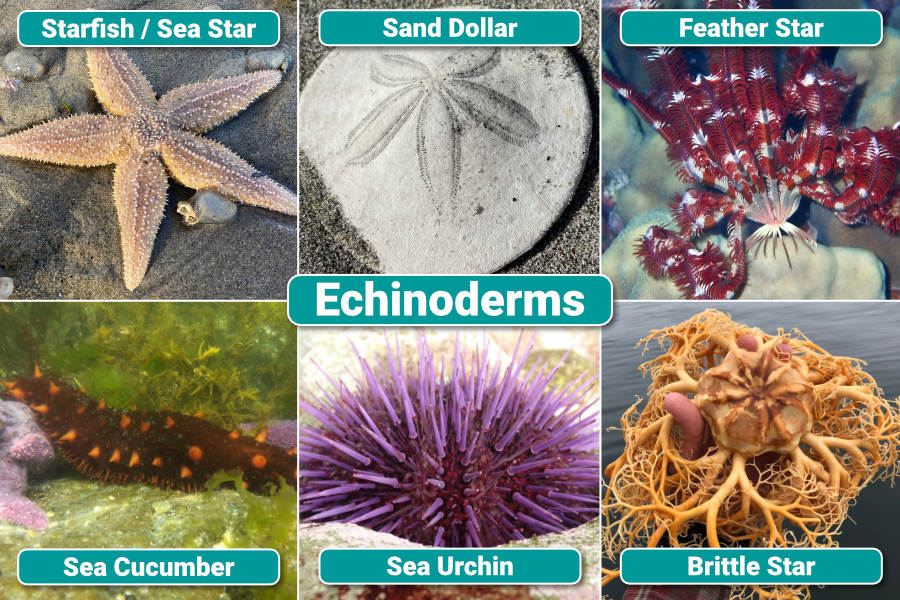Echinoderms are a group of animals that include starfish, sea urchins, sea cucumbers, brittle stars, sea lilies and feather stars. On this page is a complete guide to echinoderms, with examples of different types of echinoderms from around the world.
Page Index
What Is An Echinoderm?
An echinoderm is an animal belonging to the phylum Echinodermata. Echinoderms are characterised by their distinctive, five-point radial symmetry, unique water vascular system, tube feet, and the ability to regenerate lost body parts.
The phylum Echinodermata includes over 7,000 living species (the Catalogue of Life currently lists 7,597 living echinoderm species (source)). Echinodermata is home to all starfish / sea stars, sea urchins, sand dollars, sea cucumbers, brittle stars, sea lilies and feather stars.
Echinoderms first appeared during the Cambrian Period, and have existed in Earth’s oceans for around 521 million years.
All echinoderms live in the ocean, making Echinodermata the largest phylum of exclusively marine animals. Echinoderms inhabit a range of ecosystems, from intertidal zones to the abyssal depths of the oceans.
The bodies of echinoderms are covered in an endoskeleton of calcareous (e.g. primarily made of calcium carbonate) ossicles (plates), which can form spines or granules, giving many echinoderms a rough texture.
Covering the endoskeleton of an echinoderm is a tough skin, or epidermis, which is often brightly-colored.
Limb And Organ Regeneration
Echinoderms possess the remarkable ability to regenerate lost parts, an adaptation which serves as a defense mechanism and a means of asexual reproduction via fragmentation (the discarded body parts grow into new individuals) for some species.
Starfish can regenerate lost arms; sea cucumbers can regrow internal organs; sand dollars can replace rows of teeth; and sea urchins can repair damaged spines and skin.
Radial Symmetry
Radial symmetry is a body plan in which an organism’s body parts are arranged around a central axis, like the spokes of a wheel.
Water Vascular System
The echinoderm water vascular system is a network of fluid-filled canals and tube feet that facilitates movement, feeding, and gas exchange. It operates by hydraulic pressure, allowing echinoderms like starfish and sea urchins to extend and retract their tube feet for locomotion, adhering to surfaces, or manipulating objects.
Tube Feet
Echinoderm tube feet are small, flexible, and extendable appendages used for movement, feeding, and sensory detection, powered by the animal’s water vascular system.
Examples Of Echinoderms: Starfish (Sea Stars)
One of the most familiar types of echinoderms is the starfish. A starfish, or sea star, is an echinoderm of class Asteroidea. Starfish are characterized by their star-shaped bodies with five or more arms radiating from a central disc.
Despite the name, starfish are not fish! Echinoderms such as starfish are invertebrates and therefore far removed on the evolutionary tree from vertebrates such as fish!
Starfish are found across the world’s oceans, from tidal pools to deep-sea trenches. Like all echinoderms, they have a water vascular system for movement and feeding, and possess remarkable regenerative abilities, allowing them to regrow lost arms.
Both as predators and scavengers, starfish play a significant role in maintaining the ecological balance of marine environments.
Common Starfish
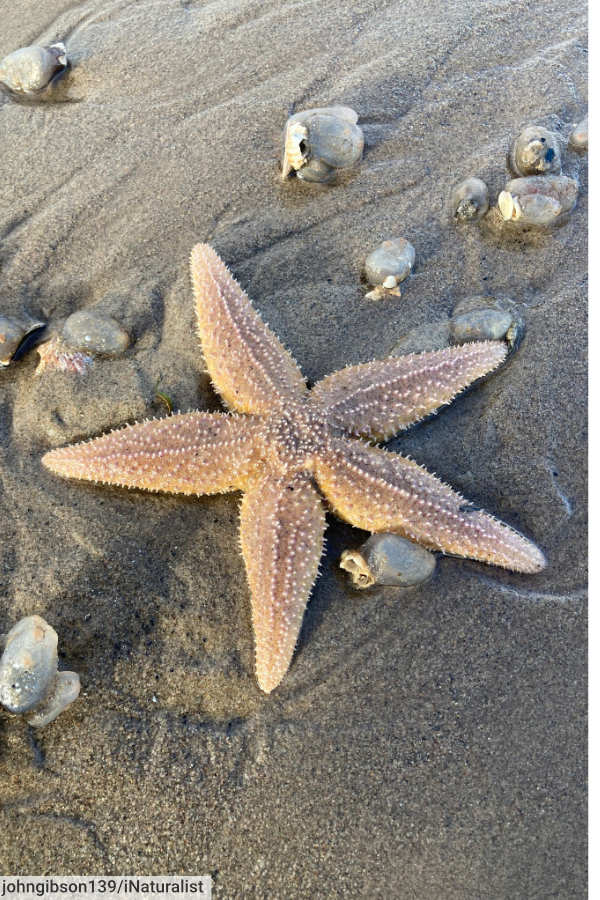
Scientific name: Asterias rubens
The common starfish is usually orange-red in color and has five robust arms. It lives in North Atlantic tidal zones, uniquely hunting by enveloping prey (mollusks and other invertebrates) and extruding its stomach to digest externally. Its remarkable regeneration abilities allow it to recover lost limbs efficiently.
Crown-of-Thorns Starfish
Scientific name: Acanthaster planci
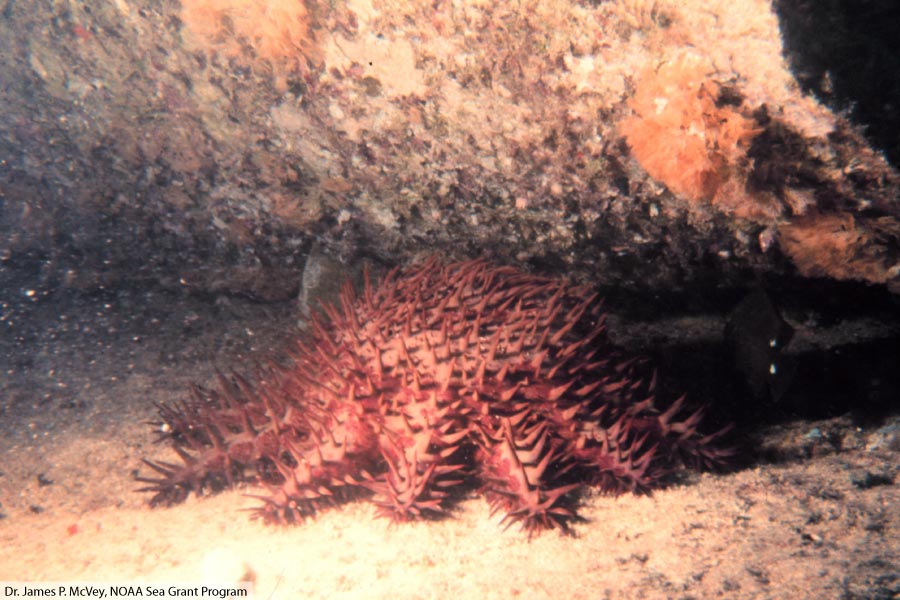
The crown-of-thorns starfish is known for its venomous spines and large size, reaching up to 80 cm (about 31 inches) in diameter. It is disc-shaped with relatively short arms.
The crown-of-thorns starfish preys on coral polyps, and can cause considerable damage to coral reefs. Its population outbreaks pose significant ecological challenges.
Royal Starfish
Scientific name: Astropecten articulates

The royal starfish has a striking purple body with bright orange margins, typically spanning 20 cm (about 8 inches) across. It inhabits sandy sea beds in the West Atlantic Ocean, feeding primarily on mollusks, and is known for its rapid burrowing ability.
Sunflower Starfish
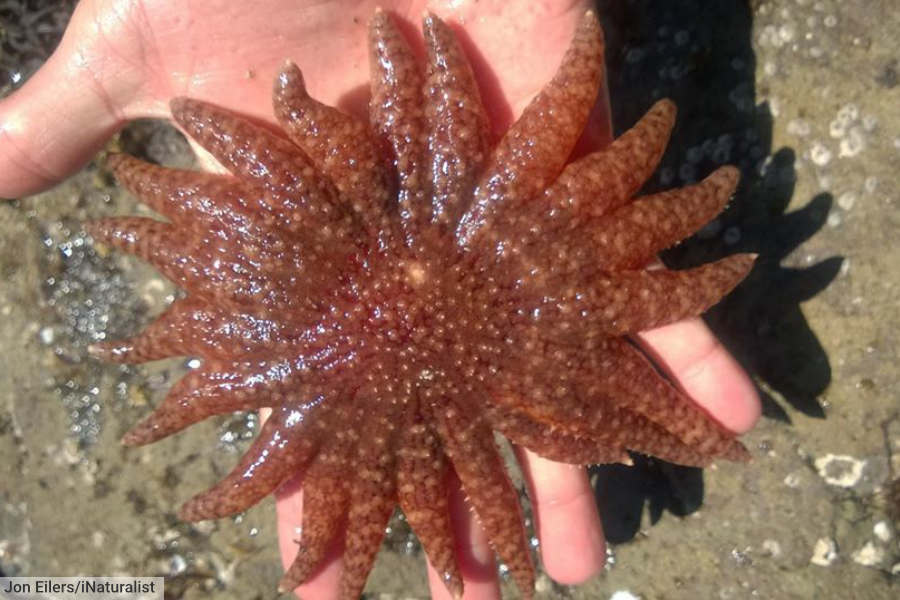
Scientific name: Pycnopodia helianthoides
The sunflower starfish is one of the largest and fastest-moving starfish, reaching up to 1 meter (about 39 inches) in diameter, with up to 24 arms. Capable of moving at one meter per minute (fast in echinoderm terms), the sunflower starfish preys on various invertebrates, including sea urchins.
Examples Of Echinoderms: Sea Urchins
A sea urchin is a small, globular, spiny echinoderm. Characterized by their hard, calcareous exoskeletons (known as tests) covered in sharp spines, sea urchins play a critical role in marine ecosystems, often grazing on algae and helping to control its growth. After starfish, they are the most familiar types of echinoderms.
Sea urchins inhabit a variety of ocean floor habitats, from shallow shores to deep sea. Many have a unique mouth structure, called Aristotle’s lantern. The spherical shape and spines of sea urchins are anti-predator adaptations.
Red Sea Urchin
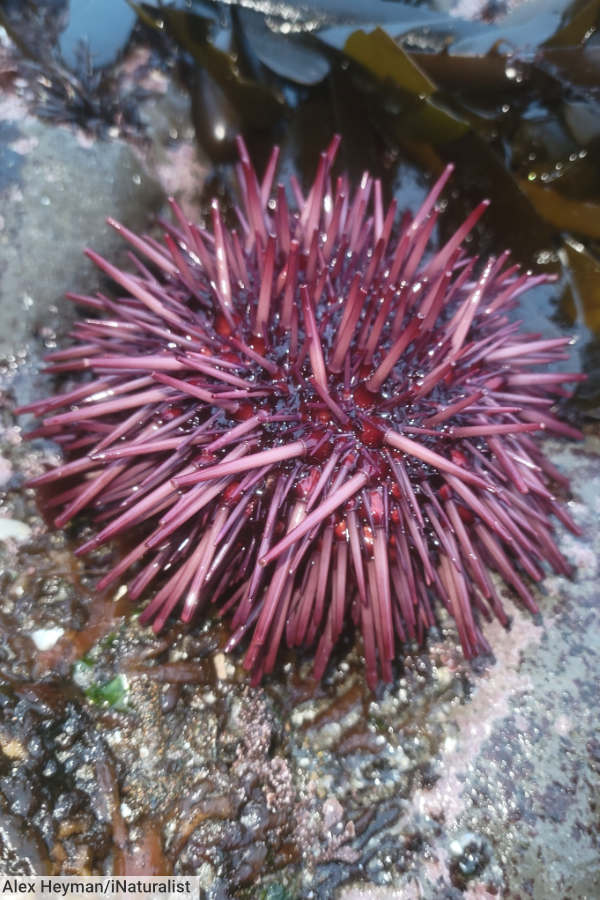
Scientific name: Strongylocentrotus franciscanus
The red sea urchin can be identified by its deep red hue and dense covering of long spines. It is one of the longest-lived sea urchins, potentially reaching over 200 years old, and can grow to about 18 cm (7 inches) in diameter. This species favors rocky bottoms in the northeastern Pacific Ocean, where it feeds on algae.
Purple Sea Urchin
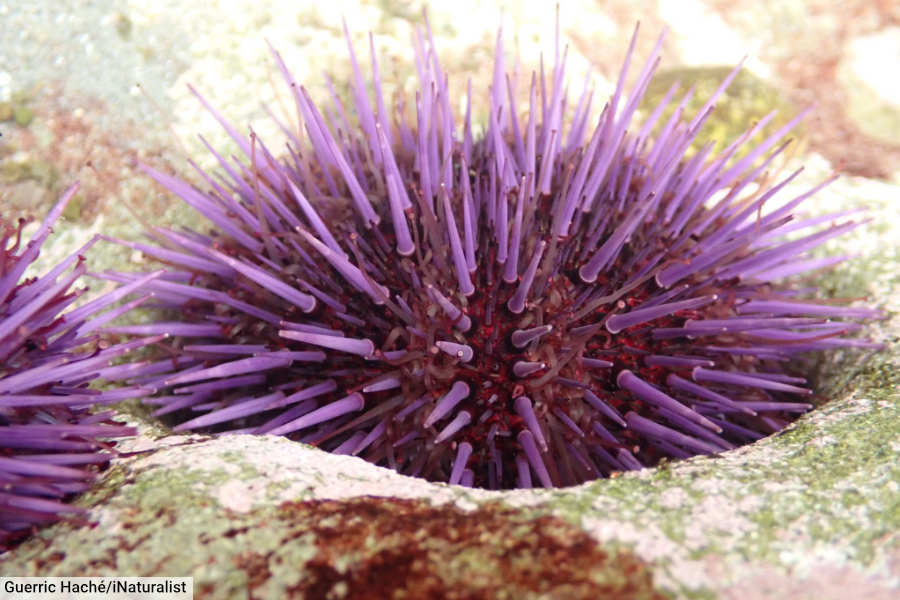
Scientific name: Strongylocentrotus purpuratus
The purple sea urchin is recognized for its vibrant purple spines and compact, round body, typically measuring about 7-10 cm (2.75-4 inches) in diameter. It consumes algae and can densely populate rocky intertidal zones of the eastern Pacific Ocean.
Green Sea Urchin
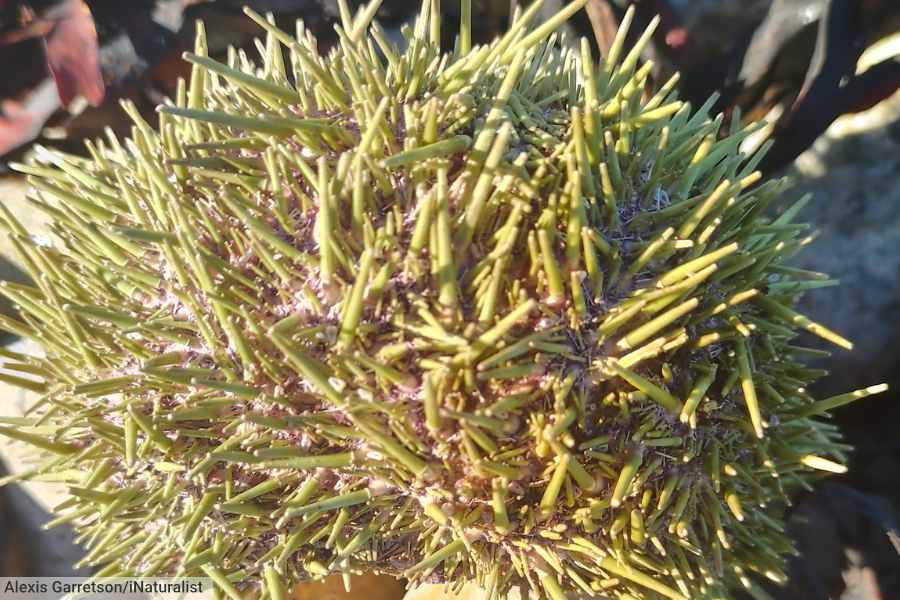
Scientific name: Strongylocentrotus droebachiensis
The green sea urchin has a characteristic greenish color, spans roughly 5-10 cm (2-4 inches) in diameter, and inhabits cold North Atlantic and Pacific waters. It grazes on seaweed and can form large feeding fronts.
In some regions, the green sea urchin is considered a pest, as it can eat kelp forests. An individual’s rough age can be calculated from its size, with each centimeter equating to a year’s worth of growth.
Examples Of Echinoderms: Sand Dollars
Sand dollars are sea urchins of order Clypeasteroida. They are flat, burrowing sea urchins with a star-shaped pattern on their rigid skeleton. They live in sandy or muddy marine beds and feed on detritus.
When alive, sand dollars are covered with velvety spines that aid in movement and respiration. When dead, their flat, spineless bodies resemble coins, hence the common name of this group.
The tests of sand dollar tests have distinctive, keyhole-shaped or flower-patterned perforations (holes) that facilitate their unique burrowing behavior and filter-feeding mechanism, allowing water to flow through their bodies for feeding and gas exchange.
Common Sand Dollar
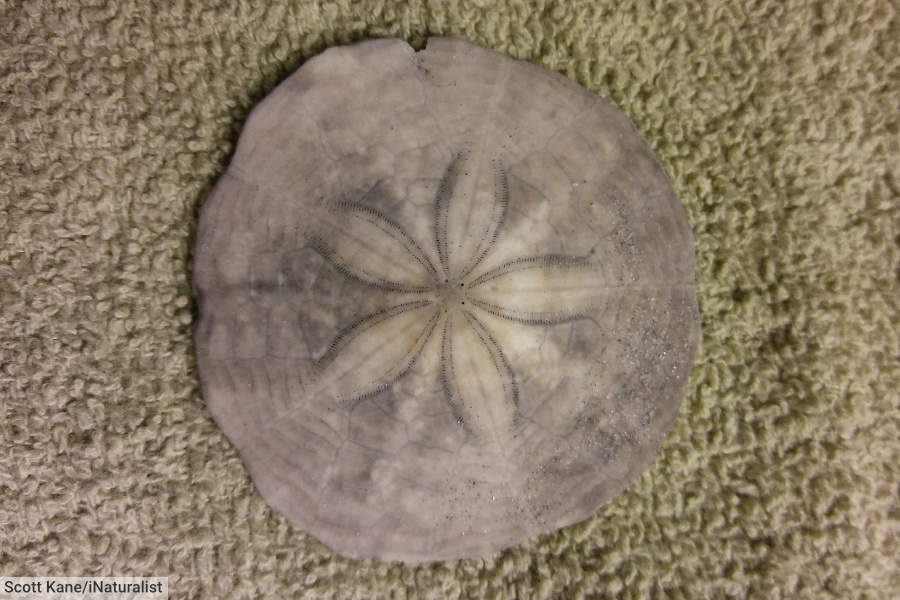
Scientific name: Echinarachnius parma
The common sand dollar is usually 5-10 cm (2-4 inches) wide, with a flat, disk-like body exhibiting a distinctive five-petaled flower pattern. Found in the North Atlantic, it lives buried in sandy substrates, feeding on microscopic organisms.
Keyhole Sand Dollar

Scientific name: Mellita quinquiesperforata
The keyhole sand dollar notable for its distinctive keyhole-shaped openings, spans around 5-8 cm (2-3 inches) in diameter. Inhabiting warm North American waters, it burrows in sandy substrates and filters plankton from the water through its perforations.
Eccentric Sand Dollar / Pacific Sand Dollar

Scientific name: Dendraster excentricus
The Eccentric sand dollar has a unique, off-center petaloid (resembling a flower petal) pattern and grows to about 8 cm (3 inches) in diameter. It inhabits the North American Pacific coast, living in sandy substrates and feeding on plankton, including small crustaceans and crustacean larvae, via suspension feeding.
Examples Of Echinoderms: Sea Cucumbers
A sea cucumber is a soft-bodied, elongated echinoderm belonging to the class Holothuroidea. These marine invertebrates are found on the ocean floor worldwide, from shallow to deep-sea environments.
Sea cucumbers play a crucial ecological role by recycling nutrients, as they feed on detritus and other organic matter. They have a leathery skin and an unusual feature: they can expel their internal organs to deter predators, a process known as evisceration, and remarkably, they can regenerate these organs.
California Sea Cucumber
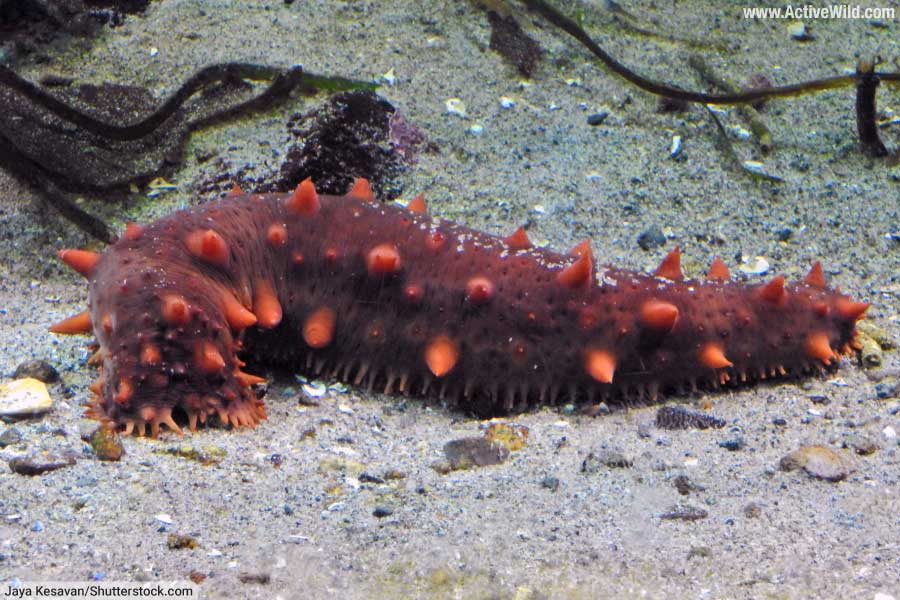
Scientific name: Parastichopus californicus
The California sea cucumber can grow up to 50 cm (about 20 inches) long, featuring a reddish-brown body with yellow spikes. Found along the Pacific coast of North America, it scavenges organic matter on the ocean floor using its twenty retractable tentacles.
Leopard Sea Cucumber
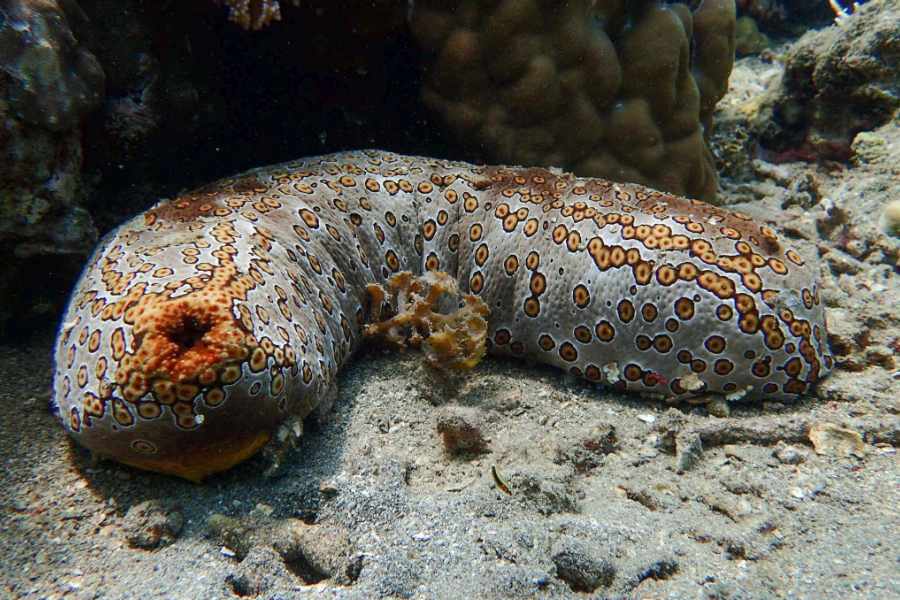
Scientific name: Bohadschia argus
The Leopard sea cucumber is distinguished by its dark body speckled with light spots, resembling a leopard’s coat, and can reach up to 60 cm (about 24 inches) in length. Inhabiting Indo-Pacific waters, this echinoderm is nocturnal, using its tentacles to feed on detritus and plankton.
A small fish, the star pearlfish Carapus mourlani is known to live inside the body of the leopard sea cucumber and other ectoderms.
Warty Sea Cucumber

Scientific name: Parastichopus parvimensis
The warty sea cucumber has a vibrant red to yellow-orange-colored body with numerous wart-like lumps. It grows to around 35 cm (about 14 inches) in length.
The species is predominantly found along the Pacific coast of North America, where it feeds on organic matter on the seafloor, playing a key role in nutrient recycling.
Sea Apple

Scientific name: Pseudocolochirus violaceus
Sea apples are a genus, Pseudocolochirus, of sea cucumbers with round, apple-like bodies. Pseudocolochirus violaceus is a colorful species with a striking mix of red, purple, and yellow hues, growing up to 20 cm (about 8 inches). Native to the Indo-Pacific, it feeds by filtering water for plankton, using its tentacles.
Examples Of Echinoderms: Brittle Stars
A brittle star is an echinoderm belonging to the class Ophiuroidea. These marine invertebrates are characterized by their slender, highly flexible arms, which radiate from a central disk.
Unlike starfish, the arms of brittle stars are distinct from the central body, allowing for swift, snake-like movements. Brittle stars inhabit a variety of marine environments, from shallow waters to deep-sea floors. They are primarily scavengers or detritivores, playing a vital role in the ocean’s ecosystem by recycling organic material. Their name derives from their easily breakable arms, which can regenerate.
Serpent Star

Scientific name: Ophiura ophiura
The serpent star has long, flexible arms and typically measures 10-15 cm (4-6 inches) in diameter. It inhabits the northeastern Atlantic Ocean and North Sea and moves in a jerky, snake-like manner as it scavenges for food in sandy or muddy substrates.
Basket Star
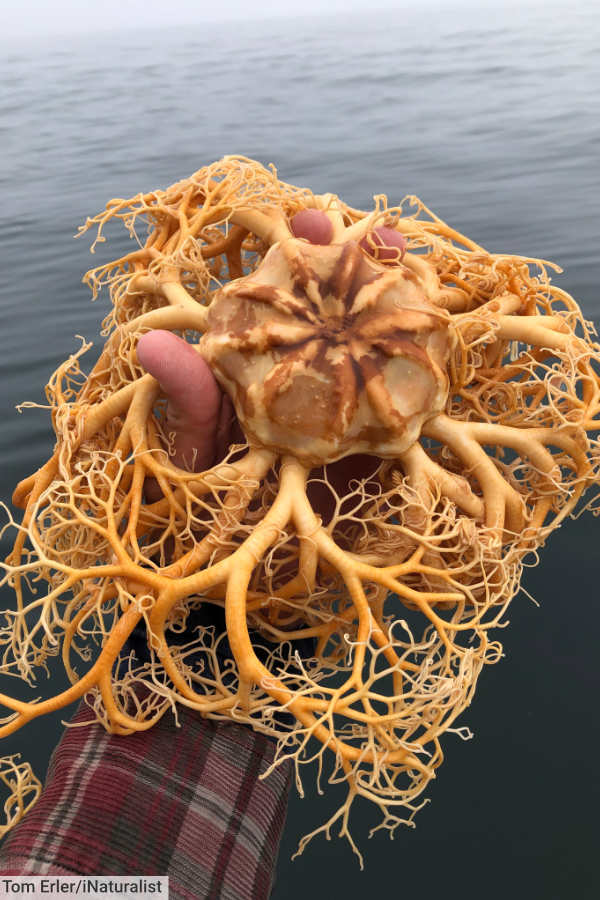
Scientific name: Gorgonocephalus eucnemis
The basket star is a brittle star with intricate, branching arms, which can extend up to 60 cm (about 24 inches) across. The arms resemble the snake-hair of a gorgon in Greek mythology, hence the species’ scientific name.
Found in cold Atlantic and Arctic waters, the species holds its arms out in currents to capture plankton.
Blunt-Spined Brittle Star

Scientific name: Ophiocoma echinata
The blunt-spined brittle star is a brittle star with long, tapering arms that are covered in small spines. The species grows to around 25 cm (about 10 inches) in diameter (including the arms). It inhabits tropical oceans worldwide and is often found on coral reefs, where it preys on small invertebrates.
Examples Of Echinoderms: Sea Lilies And Feather Stars
Crinoids, also known as sea lilies or feather stars, are echinoderms belonging to the class Crinoidea. Characterized by their long, feathery arms that are used for filter feeding, crinoids resemble a flower, with a central body attached to a stalk in some species, particularly in juveniles. Adult crinoids are often free-swimming.
Like all echinoderms, crinoids have five-point radially-symmetrical bodies, but each of their five arms is often divided into many further arms.
Crinoids inhabit both shallow water and deep-sea environments. They are ancient creatures, dating back to the Ordovician period, over 485 million years ago.
Bennett’s Bushy Feather Star
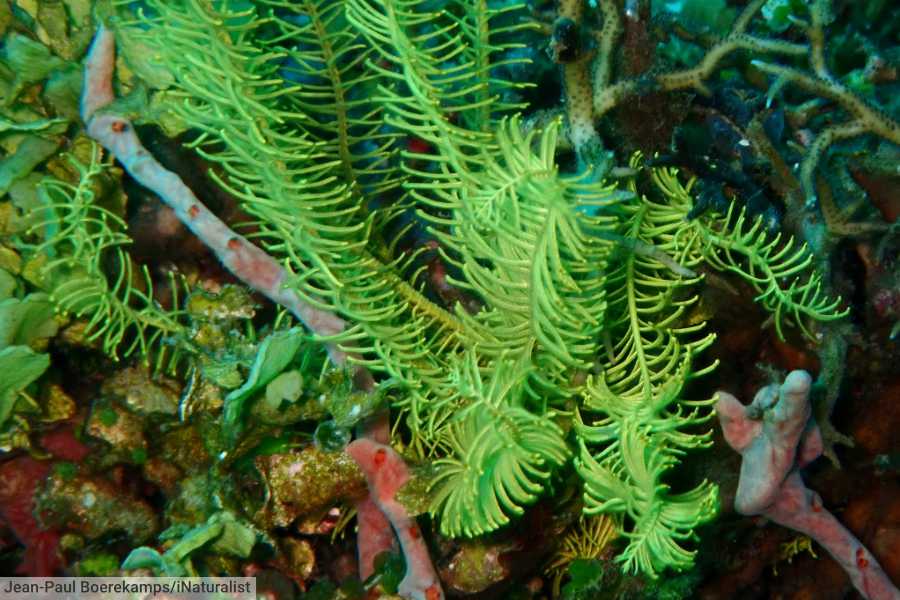
Scientific name: Oxycomanthus bennetti
Bennett’s feather star is vibrantly-colored crinoid with up to 120 intricate arms. Found in Indo-Pacific reefs, the species – unlike many crinoids – is diurnal (active during the day), actively swimming or clinging to corals.
Klunzinger’s Feather Star
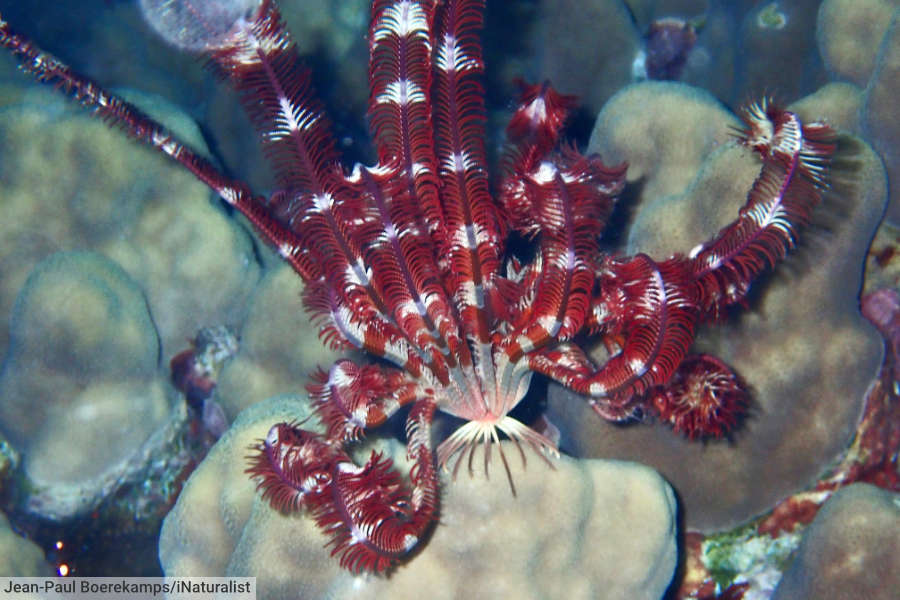
Scientific name: Dichrometra palmata
Klunzinger’s feather star is a crinoid found in shallow waters of the Indian Ocean and Western Pacific Ocean.
Discover More With Active Wild
Discover more invertebrates on this page: List Of Invertebrates
Discover different types of mollusks on this page: Mollusks Examples
You can find out more about crustaceans on this page: Crustaceans – The Ultimate Guide
You can see more ocean animals on this page: Ocean Animals List with Pictures & Facts
Visit our main animals page for links to animal information and a complete guide to the animal kingdom: Animals

